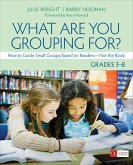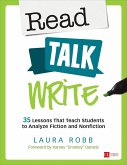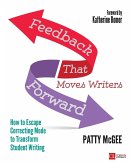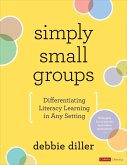Douglas Fisher, Nancy Frey, Russell J. Quaglia
Engagement by Design
Creating Learning Environments Where Students Thrive
Douglas Fisher, Nancy Frey, Russell J. Quaglia
Engagement by Design
Creating Learning Environments Where Students Thrive
- Broschiertes Buch
- Merkliste
- Auf die Merkliste
- Bewerten Bewerten
- Teilen
- Produkt teilen
- Produkterinnerung
- Produkterinnerung
The focus of this book is to provide teachers with the tools to cultivate engaged learners, which includes developing healthy relationships with their students, based on research suggesting that positive teacher-student relationships improve achievement.
Andere Kunden interessierten sich auch für
![What Are You Grouping For?, Grades 3-8 What Are You Grouping For?, Grades 3-8]() Julie T. Wright (Consultant)What Are You Grouping For?, Grades 3-848,99 €
Julie T. Wright (Consultant)What Are You Grouping For?, Grades 3-848,99 €![Read, Talk, Write Read, Talk, Write]() Laura J. RobbRead, Talk, Write37,99 €
Laura J. RobbRead, Talk, Write37,99 €![Feedback That Moves Writers Forward Feedback That Moves Writers Forward]() Patty McGeeFeedback That Moves Writers Forward35,99 €
Patty McGeeFeedback That Moves Writers Forward35,99 €![Developing Writers of Argument Developing Writers of Argument]() Michael W. SmithDeveloping Writers of Argument42,99 €
Michael W. SmithDeveloping Writers of Argument42,99 €![Simply Small Groups Simply Small Groups]() Debbie DillerSimply Small Groups26,99 €
Debbie DillerSimply Small Groups26,99 €![Teaching Literacy in Troubled Times Teaching Literacy in Troubled Times]() Allison Skerrett (USA The University of Texas at Austin)Teaching Literacy in Troubled Times41,99 €
Allison Skerrett (USA The University of Texas at Austin)Teaching Literacy in Troubled Times41,99 €![Good Grammar [Grades 6-12] Good Grammar [Grades 6-12]]() Matthew JohnsonGood Grammar [Grades 6-12]42,99 €
Matthew JohnsonGood Grammar [Grades 6-12]42,99 €-
-
-
The focus of this book is to provide teachers with the tools to cultivate engaged learners, which includes developing healthy relationships with their students, based on research suggesting that positive teacher-student relationships improve achievement.
Hinweis: Dieser Artikel kann nur an eine deutsche Lieferadresse ausgeliefert werden.
Hinweis: Dieser Artikel kann nur an eine deutsche Lieferadresse ausgeliefert werden.
Produktdetails
- Produktdetails
- Corwin Literacy
- Verlag: SAGE Publications Inc
- Seitenzahl: 194
- Erscheinungstermin: 8. September 2017
- Englisch
- Abmessung: 235mm x 191mm x 11mm
- Gewicht: 400g
- ISBN-13: 9781506375731
- ISBN-10: 1506375731
- Artikelnr.: 48895115
- Herstellerkennzeichnung
- Libri GmbH
- Europaallee 1
- 36244 Bad Hersfeld
- gpsr@libri.de
- Corwin Literacy
- Verlag: SAGE Publications Inc
- Seitenzahl: 194
- Erscheinungstermin: 8. September 2017
- Englisch
- Abmessung: 235mm x 191mm x 11mm
- Gewicht: 400g
- ISBN-13: 9781506375731
- ISBN-10: 1506375731
- Artikelnr.: 48895115
- Herstellerkennzeichnung
- Libri GmbH
- Europaallee 1
- 36244 Bad Hersfeld
- gpsr@libri.de
Douglas Fisher is professor and chair of educational leadership at San Diego State University and a leader at Health Sciences High and Middle College. Previously, Doug was an early intervention teacher and elementary school educator. He is a credentialed teacher and leader in California. In 2022, he was inducted into the Reading Hall of Fame by the Literacy Research Association. He has published widely on literacy, quality instruction, and assessment, as well as books such as Welcome to Teaching, PLC+, Teaching Students to Drive their Learning, and Student Assessment: Better Evidence, Better Decisions, Better Learning.
List of Videos
Acknowledgments
About the Authors
Chapter 1. The Inviting Classroom
Are Students Engaged?
Intentionally Inviting Classrooms
Low-Hanging Fruit
Student Voice
Engagement by Design
Conclusion
Chapter 2. Relationships
Building Relationships With Students
The Invitational Aspect of Teacher-Student Relationships
The Equitable Aspect of Teacher-Student Relationships
How Teachers Communicate Expectations Differentially
The Advocacy Aspect of Teacher-Student Relationships
Conclusion
Chapter 3. Clarity
Clarity in Teaching
Know What Students Are Supposed to Learn
Know How Students Learn
Know How to Communicate What Students Will Be Learning
Know How to Develop Success Criteria
Conclusion
Chapter 4. Challenge
Inviting the Struggle
Fluency
Stamina
Strategic Thinking
Struggle That Builds Expertise
Conclusion
Chapter 5. Engagement
The Engagement Gap
Engagement: Overused and Misunderstood
Bringing It All Together
The Engagement Equation
Voice (V)
Self-Worth (SW)
Purpose (P)
Engagement
Engaged Students
Engaged Classrooms
Engaged Student Outcomes
The Ending of One Story Is the Beginning of Another
Conclusion
References
Index
Acknowledgments
About the Authors
Chapter 1. The Inviting Classroom
Are Students Engaged?
Intentionally Inviting Classrooms
Low-Hanging Fruit
Student Voice
Engagement by Design
Conclusion
Chapter 2. Relationships
Building Relationships With Students
The Invitational Aspect of Teacher-Student Relationships
The Equitable Aspect of Teacher-Student Relationships
How Teachers Communicate Expectations Differentially
The Advocacy Aspect of Teacher-Student Relationships
Conclusion
Chapter 3. Clarity
Clarity in Teaching
Know What Students Are Supposed to Learn
Know How Students Learn
Know How to Communicate What Students Will Be Learning
Know How to Develop Success Criteria
Conclusion
Chapter 4. Challenge
Inviting the Struggle
Fluency
Stamina
Strategic Thinking
Struggle That Builds Expertise
Conclusion
Chapter 5. Engagement
The Engagement Gap
Engagement: Overused and Misunderstood
Bringing It All Together
The Engagement Equation
Voice (V)
Self-Worth (SW)
Purpose (P)
Engagement
Engaged Students
Engaged Classrooms
Engaged Student Outcomes
The Ending of One Story Is the Beginning of Another
Conclusion
References
Index
List of Videos
Acknowledgments
About the Authors
Chapter 1. The Inviting Classroom
Are Students Engaged?
Intentionally Inviting Classrooms
Low-Hanging Fruit
Student Voice
Engagement by Design
Conclusion
Chapter 2. Relationships
Building Relationships With Students
The Invitational Aspect of Teacher-Student Relationships
The Equitable Aspect of Teacher-Student Relationships
How Teachers Communicate Expectations Differentially
The Advocacy Aspect of Teacher-Student Relationships
Conclusion
Chapter 3. Clarity
Clarity in Teaching
Know What Students Are Supposed to Learn
Know How Students Learn
Know How to Communicate What Students Will Be Learning
Know How to Develop Success Criteria
Conclusion
Chapter 4. Challenge
Inviting the Struggle
Fluency
Stamina
Strategic Thinking
Struggle That Builds Expertise
Conclusion
Chapter 5. Engagement
The Engagement Gap
Engagement: Overused and Misunderstood
Bringing It All Together
The Engagement Equation
Voice (V)
Self-Worth (SW)
Purpose (P)
Engagement
Engaged Students
Engaged Classrooms
Engaged Student Outcomes
The Ending of One Story Is the Beginning of Another
Conclusion
References
Index
Acknowledgments
About the Authors
Chapter 1. The Inviting Classroom
Are Students Engaged?
Intentionally Inviting Classrooms
Low-Hanging Fruit
Student Voice
Engagement by Design
Conclusion
Chapter 2. Relationships
Building Relationships With Students
The Invitational Aspect of Teacher-Student Relationships
The Equitable Aspect of Teacher-Student Relationships
How Teachers Communicate Expectations Differentially
The Advocacy Aspect of Teacher-Student Relationships
Conclusion
Chapter 3. Clarity
Clarity in Teaching
Know What Students Are Supposed to Learn
Know How Students Learn
Know How to Communicate What Students Will Be Learning
Know How to Develop Success Criteria
Conclusion
Chapter 4. Challenge
Inviting the Struggle
Fluency
Stamina
Strategic Thinking
Struggle That Builds Expertise
Conclusion
Chapter 5. Engagement
The Engagement Gap
Engagement: Overused and Misunderstood
Bringing It All Together
The Engagement Equation
Voice (V)
Self-Worth (SW)
Purpose (P)
Engagement
Engaged Students
Engaged Classrooms
Engaged Student Outcomes
The Ending of One Story Is the Beginning of Another
Conclusion
References
Index








![Good Grammar [Grades 6-12] Good Grammar [Grades 6-12]](https://bilder.buecher.de/produkte/70/70355/70355634m.jpg)